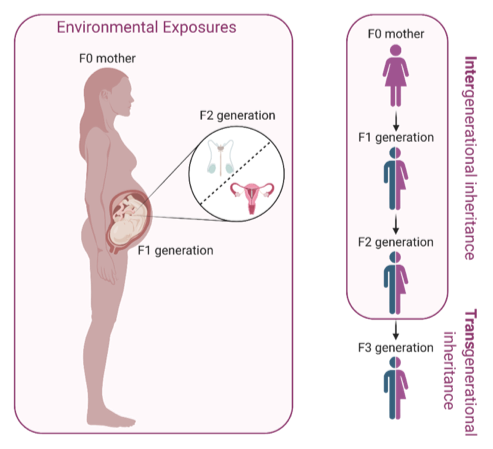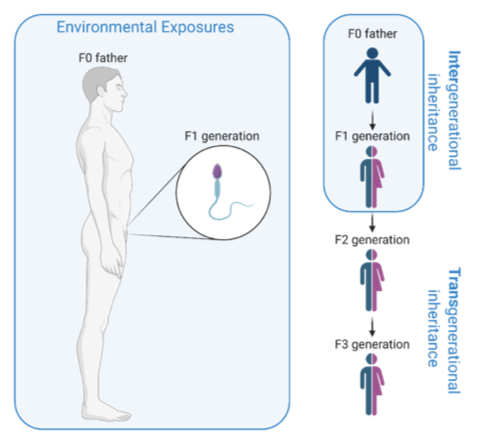Intergenerational versus transgenerational epigenetic inheritance: the parental environment
Diet, exercise, trauma, toxic substances and other environment factors can, for better or for worse, impact our epigenetics. Research has shown that the epigenetic consequences that occur due to environment and lifestyle may be passed down to children, spanning one or multiple generations, through a phenomenon called epigenetic inheritance. To study such effects requires examining multiple generations therefore epigenetic inheritance studies often rely on mice.
The inheritance of epigenetic modifications occurs when environmental exposures influence the epigenetic marks in reproductive cells—sperm and eggs. These exposures may be direct or indirect. Intergenerational epigenetic inheritance refers to epigenetic changes that occur due to a direct exposure to an environmental stressor. Conversely, when an exposure indirectly impacts eggs or sperm, the observed consequences in the offspring are characterized as transgenerational.
Determining if health outcomes are intergenerational or transgenerational relies on the studied generation, the timing of the exposure, and whether the original exposure was transmitted from the mother or the father.
Epigenetic inheritance and the mother’s environment

Transmission of an environmental exposure through the mother begins during gestation. The pregnant female (F0 generation) and her developing embryo (F1 generation), are both directly exposed to an environmental stressor. The health outcomes in the F1 generation are thus considered intergenerational epigenetic inheritance effects.
Importantly, during gestation, F1 embryos begin to develop their future reproductive cells which will give rise to their own offspring—the grandchildren of the F0 mother—known as the F2 generation. As the developing reproductive cells of F1 embryos are also directly impacted by environmental stressors, the health consequences observed in the F2 offspring are also classified as intergenerational.
Based on this model, the eggs or sperm from the F2 generation are not directly exposed to an environmental stressor and the offspring of the F2 generation, called the F3 generation, are not exposed to the original stressor either. If the epigenetic alterations persist in this generation, this is an example of transgenerational epigenetic inheritance.
Epigenetic inheritance and the father’s environment

When a father is exposed to an environmental stressor, the onset of the exposure typically begins during pre-pubertal or adulthood life. Here, both the father (F0 generation) and his developing sperm (F1 generation) are directly impacted by the environmental stressor. As a result, the health consequences in the F1 generation are coined intergenerational.
If the epigenetic marks and health consequences persist into the F2 generation, this is a result of transgenerational inheritance because the reproductive cells of the F1 generation were not directly exposed to the environmental stress.
Epigenetic reprogramming during embryo development
Two rounds of epigenetic erasure occur while the embryo is developing: one in the early embryo, and one in the future egg or sperm cells. Although these epigenetic resetting events are extensive, certain epigenetic defects inherited from eggs or sperm are not erased intergenerationally. Nonetheless, proof of transgenerational epigenetic inheritance is currently lacking in mammals and more research needs to be conducted to determine whether this phenomenon occurs in humans.

